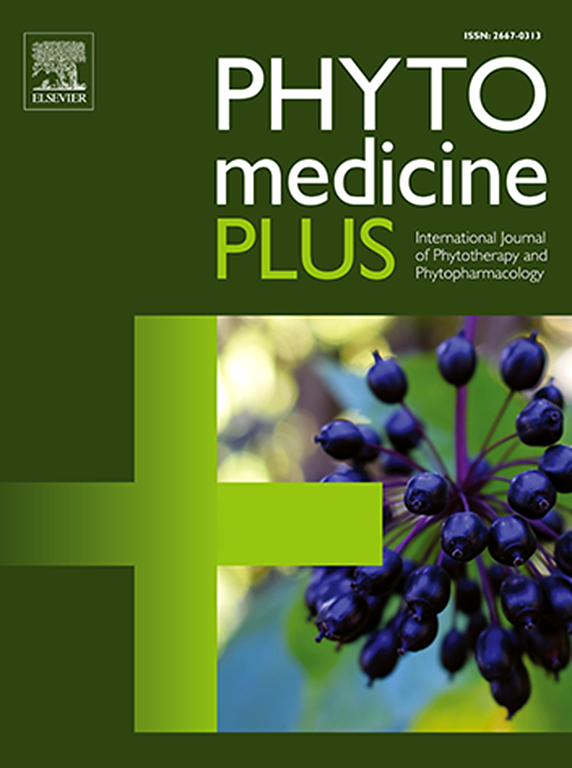Phytomedicine nanoformulations for Parkinson's disease
Q3 Pharmacology, Toxicology and Pharmaceutics
引用次数: 0
Abstract
Background
Current medications for Parkinson's disease (PD) primarily offer symptomatic relief, and often lead to adverse effects on long-term use. This highlights the need for disease-modifying therapies. In recent years, attentions of both clinicians and patients have shifted to herbal medicines that are rich source of bioactive compounds with therapeutic potential to target multiple pathways involved in PD pathology. When integrated with nanotechnology, phytomedicines can overcome key limitations of herbal molecules, such as poor solubility, low bioavailability, and difficulty in crossing the blood brain barrier (BBB).
Methods
A literature survey was conducted using PubMed. Studies were categorized into in vitro and in vivo models of the disease for assessing their relevance and impact on PD research.
Results
The review identified 26 nanoformulations from seven distinct herbal molecules and eight different whole plant extracts that have been evaluated for their effectiveness in treating PD and other brain disorders. In vitro studies demonstrated enhanced cellular uptake and neuroprotective effects, while in vivo models showed improved pharmacokinetics, BBB permeability and neuroprotective outcomes. Additionally, nine plant-derived compounds with potential effects against PD, but are not nanoformulated were investigated, highlighting their neuroprotective mechanisms but exposing the existing limitations. This article emphasizes the improved neuroprotective effects of nanoformulated herbal compounds in cellular and animal models of PD and outlines the mechanisms by which these nanoformulations enhance BBB penetration.
Conclusions
Phytomedicines formulated using nanoliposomes, nanoemlusions, polymeric nanoparticles, nanocrystals and metal nanoparticles have shown promise in improving the drug bioavailability and BBB penetration, resulting in better therapeutic effect in PD cellular and animal models. However, challenges such as scalability, regulatory compliance, and concerns over long term safety of these nanoformulations have to be considered for them to be clinically viable. Hence addressing these issues through rigorous preclinical and clinical testing is essential to confirm their safety and therapeutic potential. Further advancements in PD treatment could be achieved by developing multicomponent herbal nanoformulations that act synergistically on multiple PD targets. This approach may be effective in addressing the underlying pathogenesis of PD, thereby slowing the disease progression.

帕金森病的植物药物纳米配方
背景:目前治疗帕金森病(PD)的药物主要提供症状缓解,长期使用往往导致不良反应。这凸显了对疾病修饰疗法的需求。近年来,临床医生和患者的注意力都转向了富含生物活性化合物的草药,这些药物具有针对PD病理过程中涉及的多种途径的治疗潜力。当与纳米技术相结合时,植物药物可以克服草药分子的关键限制,如低溶解度、低生物利用度和难以穿过血脑屏障(BBB)。方法采用PubMed进行文献调查。研究分为体外和体内模型,以评估其对PD研究的相关性和影响。结果从7种不同的草药分子和8种不同的全植物提取物中鉴定出26种纳米配方,并对其治疗帕金森病和其他脑部疾病的有效性进行了评估。体外研究显示增强细胞摄取和神经保护作用,而体内模型显示改善药代动力学,血脑屏障通透性和神经保护结果。此外,我们还研究了9种植物源性化合物,它们具有抗帕金森病的潜在作用,但不是纳米制剂,强调了它们的神经保护机制,但暴露了现有的局限性。本文强调了纳米配方草药化合物在PD细胞和动物模型中的神经保护作用,并概述了这些纳米配方增强血脑屏障渗透的机制。结论纳米脂质体、纳米乳液、聚合物纳米颗粒、纳米晶体和金属纳米颗粒配制的生物药物有望提高药物的生物利用度和血脑屏障渗透,在PD细胞和动物模型中具有较好的治疗效果。然而,这些纳米制剂的可扩展性、法规遵从性以及对其长期安全性的担忧等挑战必须被考虑,以使其在临床上可行。因此,通过严格的临床前和临床试验来解决这些问题对于确认它们的安全性和治疗潜力至关重要。PD治疗的进一步进展可以通过开发多组分草药纳米制剂来实现,这些纳米制剂可以协同作用于多个PD靶点。这种方法可能有效地解决PD的潜在发病机制,从而减缓疾病的进展。
本文章由计算机程序翻译,如有差异,请以英文原文为准。
求助全文
约1分钟内获得全文
求助全文
来源期刊

Phytomedicine Plus
Medicine-Complementary and Alternative Medicine
CiteScore
3.70
自引率
0.00%
发文量
178
审稿时长
81 days
期刊介绍:
 求助内容:
求助内容: 应助结果提醒方式:
应助结果提醒方式:


